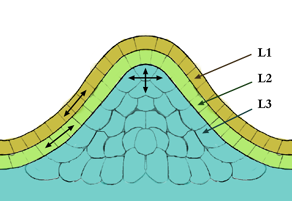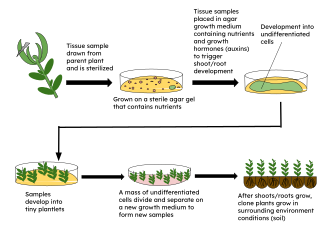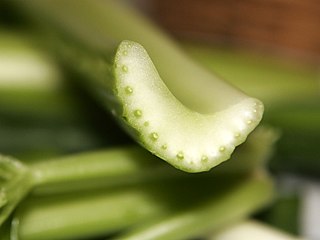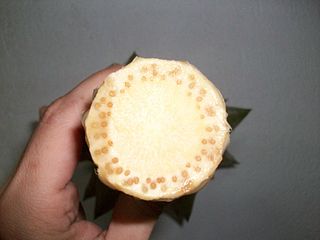
A cotyledon is a significant part of the embryo within the seed of a plant, and is defined as "the embryonic leaf in seed-bearing plants, one or more of which are the first to appear from a germinating seed." The number of cotyledons present is one characteristic used by botanists to classify the flowering plants (angiosperms). Species with one cotyledon are called monocotyledonous ("monocots"). Plants with two embryonic leaves are termed dicotyledonous ("dicots").

In the fields of horticulture and botany, the term deciduous means "falling off at maturity" and "tending to fall off", in reference to trees and shrubs that seasonally shed leaves, usually in the autumn; to the shedding of petals, after flowering; and to the shedding of ripe fruit. The antonym of deciduous in the botanical sense is evergreen.

The meristem is a type of tissue found in plants. It consists of undifferentiated cells capable of cell division. Cells in the meristem can develop into all the other tissues and organs that occur in plants. These cells continue to divide until a time when they get differentiated and then lose the ability to divide.

In botany, phyllotaxis or phyllotaxy is the arrangement of leaves on a plant stem. Phyllotactic spirals form a distinctive class of patterns in nature.

Auxins are a class of plant hormones with some morphogen-like characteristics. Auxins play a cardinal role in coordination of many growth and behavioral processes in plant life cycles and are essential for plant body development. The Dutch biologist Frits Warmolt Went first described auxins and their role in plant growth in the 1920s. Kenneth V. Thimann became the first to isolate one of these phytohormones and to determine its chemical structure as indole-3-acetic acid (IAA). Went and Thimann co-authored a book on plant hormones, Phytohormones, in 1937.

Sclereids are a reduced form of sclerenchyma cells with highly thickened, lignified cellular walls that form small bundles of durable layers of tissue in most plants. The presence of numerous sclereids form the cores of apples and produce the gritty texture of guavas.

Micropropagation or tissue culture is the practice of rapidly multiplying plant stock material to produce many progeny plants, using modern plant tissue culture methods.

The axillary bud is an embryonic or organogenic shoot located in the axil of a leaf. Each bud has the potential to form shoots, and may be specialized in producing either vegetative shoots or reproductive shoots (flowers). Once formed, a bud may remain dormant for some time, or it may form a shoot immediately.

A plant cutting is a piece of a plant that is used in horticulture for vegetative (asexual) propagation. A piece of the stem or root of the source plant is placed in a suitable medium such as moist soil. If the conditions are suitable, the plant piece will begin to grow as a new plant independent of the parent, a process known as striking. A stem cutting produces new roots, and a root cutting produces new stems. Some plants can be grown from leaf pieces, called leaf cuttings, which produce both stems and roots. The scions used in grafting are also called cuttings.

Gynoecium is most commonly used as a collective term for the parts of a flower that produce ovules and ultimately develop into the fruit and seeds. The gynoecium is the innermost whorl of a flower; it consists of pistils and is typically surrounded by the pollen-producing reproductive organs, the stamens, collectively called the androecium. The gynoecium is often referred to as the "female" portion of the flower, although rather than directly producing female gametes, the gynoecium produces megaspores, each of which develops into a female gametophyte which then produces egg cells.

A seedling is a young sporophyte developing out of a plant embryo from a seed. Seedling development starts with germination of the seed. A typical young seedling consists of three main parts: the radicle, the hypocotyl, and the cotyledons. The two classes of flowering plants (angiosperms) are distinguished by their numbers of seed leaves: monocotyledons (monocots) have one blade-shaped cotyledon, whereas dicotyledons (dicots) possess two round cotyledons. Gymnosperms are more varied. For example, pine seedlings have up to eight cotyledons. The seedlings of some flowering plants have no cotyledons at all. These are said to be acotyledons.
An epicotyl is important for the beginning stages of a plant's life. It is the region of a seedling stem above the stalks of the seed leaves of an embryo plant. It grows rapidly, showing hypogeal germination, and extends the stem above the soil surface. A common misconception is that the epicotyl, being closer to the apex of the plant, is the first part to emerge after germination - rather, the hypocotyl, the region of the stem between the point of attachment of the cotyledons and the root - forms a hook during hypogeal germination and pushes out of the soil, allowing the more delicate tissues of the plumules and apical meristem to avoid damage from pushing through the soil. The epicotyl will expand and form the point of attachment of the shoot apex and leaf primordia or "first true leaves". Cotyledons may remain belowground or be pushed up aboveground with the growing stem depending on the plant species in question.

Vascular tissue is a complex conducting tissue, formed of more than one cell type, found in vascular plants. The primary components of vascular tissue are the xylem and phloem. These two tissues transport fluid and nutrients internally. There are also two meristems associated with vascular tissue: the vascular cambium and the cork cambium. All the vascular tissues within a particular plant together constitute the vascular tissue system of that plant.

A primordium in embryology, is an organ or tissue in its earliest recognizable stage of development. Cells of the primordium are called primordial cells. A primordium is the simplest set of cells capable of triggering growth of the would-be organ and the initial foundation from which an organ is able to grow. In flowering plants, a floral primordium gives rise to a flower.
Flower differentiation is a plant process by which the shoot apical meristem changes its anatomy to generate a flower or inflorescence in lieu of other structures. Anatomical changes begin at the edge of the meristem, generating first the outer whorls of the flower - the calyx and the corolla, and later the inner whorls of the flower, the androecium and gynoecium.

Phytomorphology is the study of the physical form and external structure of plants. This is usually considered distinct from plant anatomy, which is the study of the internal structure of plants, especially at the microscopic level. Plant morphology is useful in the visual identification of plants. Recent studies in molecular biology started to investigate the molecular processes involved in determining the conservation and diversification of plant morphologies. In these studies transcriptome conservation patterns were found to mark crucial ontogenetic transitions during the plant life cycle which may result in evolutionary constraints limiting diversification.
This page provides a glossary of plant morphology. Botanists and other biologists who study plant morphology use a number of different terms to classify and identify plant organs and parts that can be observed using no more than a handheld magnifying lens. This page provides help in understanding the numerous other pages describing plants by their various taxa. The accompanying page—Plant morphology—provides an overview of the science of the external form of plants. There is also an alphabetical list: Glossary of botanical terms. In contrast, this page deals with botanical terms in a systematic manner, with some illustrations, and organized by plant anatomy and function in plant physiology.
Evolutionary developmental biology (evo-devo) is the study of developmental programs and patterns from an evolutionary perspective. It seeks to understand the various influences shaping the form and nature of life on the planet. Evo-devo arose as a separate branch of science rather recently. An early sign of this occurred in 1999.
Important structures in plant development are buds, shoots, roots, leaves, and flowers; plants produce these tissues and structures throughout their life from meristems located at the tips of organs, or between mature tissues. Thus, a living plant always has embryonic tissues. By contrast, an animal embryo will very early produce all of the body parts that it will ever have in its life. When the animal is born, it has all its body parts and from that point will only grow larger and more mature. However, both plants and animals pass through a phylotypic stage that evolved independently and that causes a developmental constraint limiting morphological diversification.

In plant morphology, thorns, spines, and prickles, and in general spinose structures, are hard, rigid extensions or modifications of leaves, roots, stems, or buds with sharp, stiff ends, and generally serve the same function: physically deterring animals from eating the plant material.














